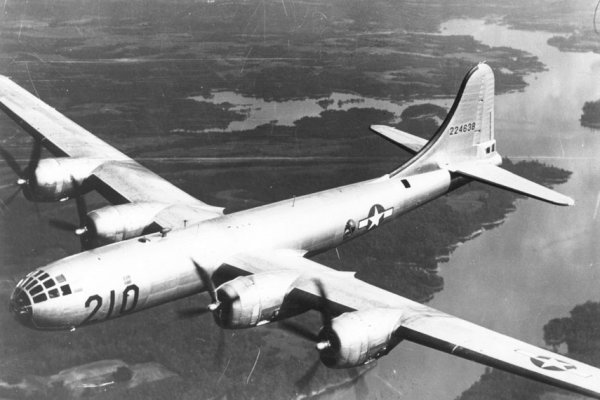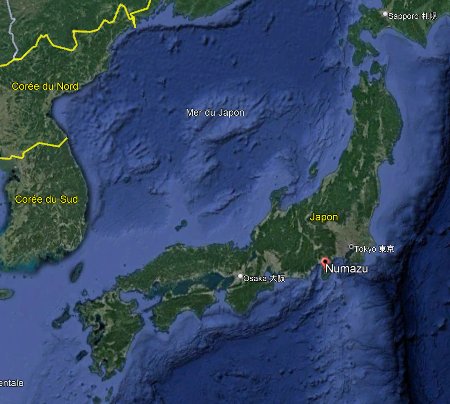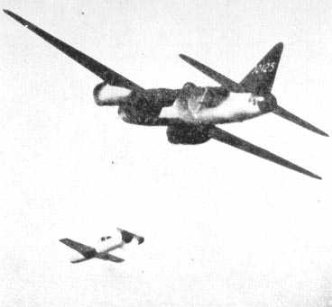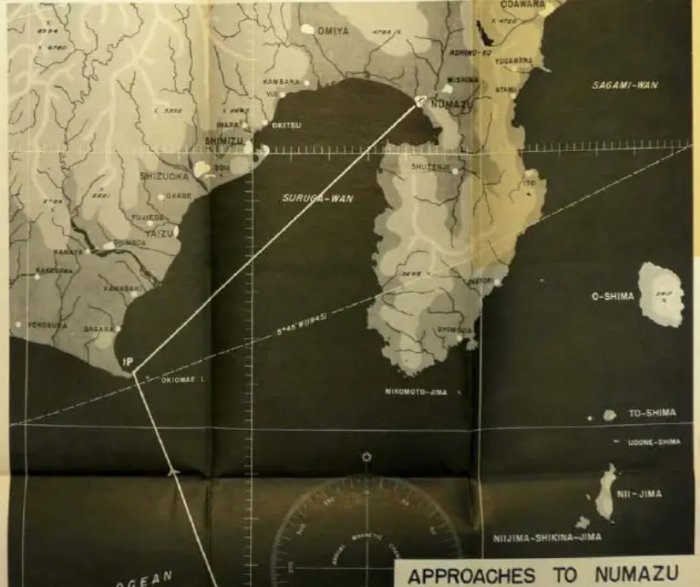ACUFO-1945-07-17-NUMAZU-1
The U.S. Army Air Forces Tactical Mission Report 271-274 of 16-17 July 1945, by the Headquarters of the XXIst Bomber Command, noted that during Mission 271, performed on 16-17 July 1945, over the Numazu Urban Area, Japan, by 119 B-29's of the 58th Bombardment Wing, between 01:13 a.m. and 02:52 a.m. local time, one light “was seen on the bomb run at 10,800 feet. This was observed 500 feet above the B-29 and seemed to be gaining. When within 500 feet of the B-29 the light went off and turned to the right and disappeared.”
The same or another sighting was also mentioned in the same report as: “One aircraft observed a red light high at 6 o'clock. This red light passed to the right of the B-29 making sharp turns. At the time of this observation tracer fire was being directed at the B-29 from the ground.”
The report states that in the opinion of the interrogation officer the sharp maneuvers engaged in by the light which followed the B-29 indicates that it was not a Japanese “Baka” piloted rocket-propelled flying bomb.
This comment certainly was prompted by the fact that another crew in the same mission did report sighting an aircraft believed to be a Japanese “Betty” bomber between the initial point and the target, flying from 7 to 11 o'clock level at 10,000 feet. The “Betty” was seen to release what was believed to be a “Baka” from about 11 o'clock level, and the supposed Baka flashed past the B-29 from 11 o'clock to 7 o'clock and then was observed exploding in the distance. No jet was observed. The B-29 gunners did not fire at the objet.
The report indicates that the mission had taken off from Iwo Jima and landed back there. There was a 10/10 undercast. Although 21 enemy aircraft were seen, none attacked the B-29's. Flak was meager and inaccurate and several ineffective searchlights were seen trying to pierce the undercast.
| Date: | July 17, 1945 |
|---|---|
| Time: | Between 01:13 a.m. and 02:52 a.m. |
| Duration: | ? |
| First known report date: | July 17, 1945 |
| Reporting delay: | Hours. |
| Country: | Japan |
|---|---|
| State/Department: | Shizuoka |
| City or place: | Numazu |
| Number of alleged witnesses: | 1 to 11 |
|---|---|
| Number of known witnesses: | ? |
| Number of named witnesses: | 0 |
| Reporting channel: | Military mission report. |
|---|---|
| Visibility conditions: | Night, 10/10 undercast. |
| UFO observed: | Yes. |
| UFO arrival observed: | Yes. |
| UFO departure observed: | |
| UFO action: | Yes. |
| Witnesses action: | Did not fire. |
| Photographs: | No. |
| Sketch(s) by witness(es): | No. |
| Sketch(es) approved by witness(es): | No. |
| Witness(es) feelings: | ? |
| Witnesses interpretation: | ? |
| Sensors: |
[X] Visual: 1 to 11.
[ ] Airborne radar: [ ] Directional ground radar: [ ] Height finder ground radar: [ ] Photo: [ ] Film/video: [ ] EM Effects: [ ] Failures: [ ] Damages: |
|---|---|
| Hynek: | ? |
| Armed / unarmed: | Armed, 12 Browning M2 12,7 mm machine guns. |
| Reliability 1-3: | 3 |
| Strangeness 1-3: | 2 |
| ACUFO: | Unidentified. |
[Ref. aaf1:] U.S. ARMY AIR FORCES:
A report noted what follows, as having occurred during Mission 271, on 16-17 July 1945, over the Numazu Urban Area, Japan.
This raid was performed by 119 B-29's of the 58th Bombardment Wing, in the night, between 1613Z (01:13 a.m. local time) and 1752Z (02:52 a.m. local time), with flight altitudes 10 600 - 11 600 feet. The planes took off from Iwo Jima and landed back there. There was a 10/10 undercast.
Flak was meager and inaccurate and several ineffective searchlights were seen trying to pierce the undercast.
(3) One light was seen on the bomb run at 10,800 feet. This was observed 500 feet above the B-29 and seemed to be gaining. When within 500 feet of the B-29 the light went off and turned to the right and disappeared. In the opinion of the interrogation officer the sharp maneuvers engaged in by the light which followed the B-29 failed to support the Baka theory.

|
The above is what was cited in the UFO literature. It should be noted that another crew reported:

|
(1) Although 21 aircraft were seen none attacked. One crew reported sighting an aircraft believed to be a Betty between the initial point and the target. the Betty flew from 7 to 11 o'clock level at 10,000 feet. It was seen to release what was believed to be a Baka from about 11 o'clock level. The supposed Baka flashed past the B-29 from 11 o'clock to 7 o'clock and then was observed exploding in the distance. No jet was observed. The B-29 gunners did not fire at the objet.
And:

|
(2) One B-29 reported sighting a “ball of fire” in the vicinity of the target at an altitude of 10,000 feet. The “ball of fire” followed the plane level and seemed to be gaining, when it disappeared into smoke on the right of the B-29.
And also, this sighting; which was picked up by ufologists as another UFO case:

|
(4) One aircraft observed a red light high at 6 o'clock. This red light passed to the right of the B-29 making sharp turns. At the time of this observation tracer fire was being directed at the B-29 from the ground.
[Ref. prt4:] JAN ALDRICH - "PROJECT 1947":
N - 1945.07.16/17 - Night, near Numazu, Japan.
B-29, 58th Wing, 58th Wings, Mission #271 one light seen at 10,800 feet about 500 feet above B-29 and gaining. When within 500 feet of the B-29, the light turned right, went off and disappeared. (Intel Officer: sharp maneuvers do not support Baka theory.) (Mission 271-274 16/17 July 1945, HQ 21st Bomber Command)
[Ref. dwn1:] DOMINIQUE WEINSTEIN:
At night the pilot of a B-29 of the 58th Wing observed one light at an altitude of 10,800 ft about 500 ft above his aircraft and gaining. When within 500 ft of the B-29, the light turned right, went off and disappeared. (Intelligence officer's comment: “Sharp maneuvers do not support Baka Theory”.
Sources: Project 1947, Jan Aldrich / Mission 271-274, 16-17 July 1945, HQ 21st Bomber Command.
[Ref. dwn2:] DOMINIQUE WEINSTEIN:
At night the pilot of a B-29 of the 58th Wing observed one light at an altitude of 10,800 ft about 500 ft above his aircraft and gaining. When within 500 ft of the B-29, the light turned right, went off and disappeared. (Intelligence officer's comment: “Sharp maneuvers do not support Baka Theory”.
Sources: Project 1947, Jan Aldrich / Mission 271-274, 16-17 July 1945, HQ 21st Bomber Command.
The Boeing B-29 “Superfortress” was the heaviest bomber of the U.S. Army Air Forces, used in operations from May 8, 1944 and on. Its maximum speed was 574 km/h.
Its defensive armament was 12 Browning M2 12.7 mm machine guns.

|

|
Jet planes:
The report noted that no jets were seen during the mission. At the time, it was sensible to suspect that the Japanese air forces would start using jet planes, as the Germans gave them the technical information about their Me-262 jet fighter. But the Japanese then only managed to build two prototypes, only one of them flew, and was never used in operations. This means that the potential UFO reported here cannot have been a jet plane.
“Baka”:
The Yokosuka MXY-7 Ohka was a Japanese rocket plane used for suicide “Kamikaze” missions at the end of World War II. It carried an explosive charge of 1,200 kg, constituting a flying bomb, it was dropped from the belly of a twin-engine Mitsubishi G4M “Betty” bomber. Guidance was provided by the pilot alone, the machine flew at 900 km/h and was not very maneuverable, it is known that many “Baka” had exploded in flight before reaching their target. The first use took place on March 16, 1945, the last recorded use took place on June 22, 1945.
In historical sources, all “Baka” attacks were carried out by day and against ships. I haven't found any mention of a nighttime “Baka” attack on bombers.
Below: photo of the drop of a “Baka” by a Japanese bomber, by day:

|
The mission report indicates that Mission #271 of the night of July 16-17, 1945, by the 58th Bomb Wing took off from Tinian, flew over Okinawa and bombed Numazu. 128 aircraft, all B-29, were involved. The targets were plants, road junctions, the harbor.

|
Above: planned route for Mission #271, in the mission report.
The bombers were assigned 10.800 feet flight altitude with individual planes altitudes left to the decisions of the Wing. There was a 10/10 cloud under cast under the bombers and over the targets, they used the onboard radar to find the targets.
As with many reports in 1945 over targets in Japan, it is hard to assess exactly what happened. Here we have one crew reporting what they thought was a “Betty” bomber dropping a “Baka” which exploded; another crew reporting what was possibly the same event, and a third crew reporting at a different time a light pacing them, performing maneuvers that in the officer's opinion excluded that it could have been a “Baka”.
Unidentified.
* = Source is available to me.
? = Source I am told about but could not get so far. Help needed.
| Main author: | Patrick Gross |
|---|---|
| Contributors: | None |
| Reviewers: | None |
| Editor: | Patrick Gross |
| Version: | Create/changed by: | Date: | Description: |
|---|---|---|---|
| 0.1 | Patrick Gross | December 6, 2023 | Creation, [aaf1], [prt4], [dwn1], [dwn2]. |
| 1.0 | Patrick Gross | December 6, 2023 | First published. |